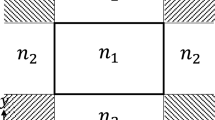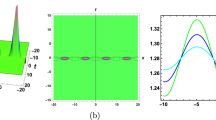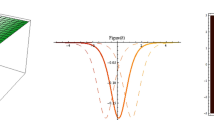Abstract
A bianisotropic waveguide can be defined as a cylindrical waveguide filled with bianisotropic materials, and all the conventional waveguides are special cases of the bianisotropic waveguide. In this paper, guided wave propagation in bianisotropic waveguide is analyzed by the theory of linear operators, and two types of adjoint waveguides and inner products are introduced respectively. Based on the concept of adjoint waveguides, the functional expressions of the field equations can be obtained, and from which the eigenvalue problem of the bianisotropic waveguide can be solved. Also, bi-orthogonality relations of guided modes are derived. These biorthogonality relations reported here can be used to expand electromagnetic fields in terms of a complete set of modes in straight bianisotropic waveguide. As an example of application, mode matching formulae for a discontinuity problem are given.
Similar content being viewed by others
References
J. A. Kong,Electromagnetic Wave Theory, New York: Wiley, 1986.
J. A. Kong, “Theorems of bianisotropic media,”,Proc. IEEE, vol.60, pp.1036–1046, Sept. 1972.
J. A. Kong, “Optics of bianisotropic media,”J. Opt. Soc. Amer., vol.64, pp.1304–1308, 1974.
D. K. Cheng and J. A. Kong, “Covariant descriptions of bianisotropic media,”Proc. IEEE, vol.56, pp.248–251, 1968.
J. L. Tsalamengas, “Interaction of Electromagnetic Waves with General Bianisotropic Slabs,”IEEE Trans. Microwave Theory Tech., vol.MTT-40, pp.1870–1878, Oct. 1992.
P. Pelet and N. Engheta, “The theory of chirowaveguides”,IEEE Trans. Microwave Theory Tech., vol.MTT-38, pp.90–98, Jan. 1990.
N. Engheta and P. Pelet. “Modes in chirowaveguides”,Opt. Lett., vol.14, pp.593–595, June 1989.
F. Mariotte and N. Engheta, “Reflection and transmission of guided electromagnetic waves at an air-chiral interface and at a chiral slab in a parallel-plate waveguide”,IEEE Trans. Microwave Theory Tech., vol.MTT-41, pp.1895–1906, Nov. 1993.
N. Engheta and P. Pelet, “Mode orthogonality in chirowaveguides”,IEEE Trans. Microwave Theory Tech., vol.MTT-38, pp.1631–1634, Jan. 1990.
C. R. Paiva and A. M. Barbosa, “A linear-operator formalism for the analysis of inhomogeneous biisotropic planar waveguides”,IEEE Trans. Microwave Theory Tech., vol.MTT-40, pp.672–678, Apr. 1993.
A. D. Bresler, G. H. Joshi and N. Marcuvitz, “Orthogonality properties for modes in passive and active uniform waveguides,”J. Appl. Phys., vol.29, pp.794–799, May 1958.
L. B. Felsen and N. Marcuvitz,Radiation and Scattering of Waves. Prentice-Hall, 1973.
B. Friedman,Principles and Techniques of Applied Mathematics. New York: Wiley, 1956.
W. X. Zhang,Engineering Electromagnetism: Functional Methods. Ellis Horwood, 1991.
S. J. Chung and C. H. Chen. “Partial variational principle for electromagnetic field problems: theory and applications”.IEEE Trans. Microwave Theory Tech., vol.MTT-36, pp.473–479, Mar. 1988.
S. K. Jeng and C. H. Chen, “On variational electromagnetics: theory and application,”IEEE Trans. Antennas Propagat., vol.AP-32, pp.902–907, Sept. 1984.
T. E. Rozzi and G. H. In'tveld, “Field and network analysis of interacting step discontinuities in planar dielectric waveguides,”IEEE Trans. Microwave Theory Tech., vol.MTT-27, pp.303–309, Apr. 1979.
H. Shigesawa and M. Tsuji, “A new equivalent network method for analyzing discontinuity properties of open dielectric waveguides.”IEEE Trans. Microwave Theory Tech., vol.MTT-37, pp.3–14, Jan. 1989.
Author information
Authors and Affiliations
Rights and permissions
About this article
Cite this article
Wu, X. A linear-operator formalism for bianisotropic waveguides. Int J Infrared Milli Waves 16, 419–434 (1995). https://doi.org/10.1007/BF02096328
Received:
Issue Date:
DOI: https://doi.org/10.1007/BF02096328




